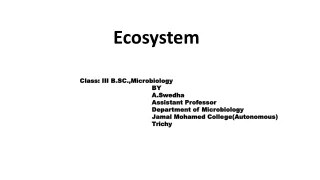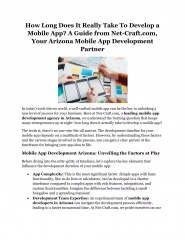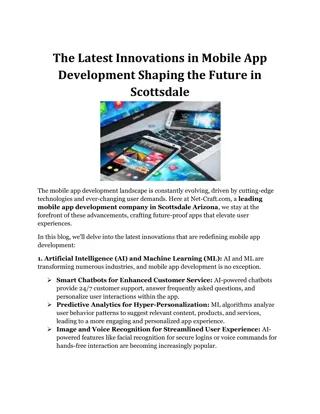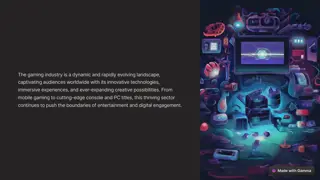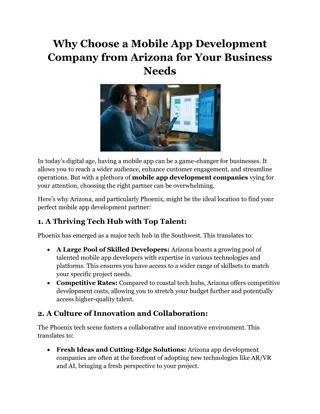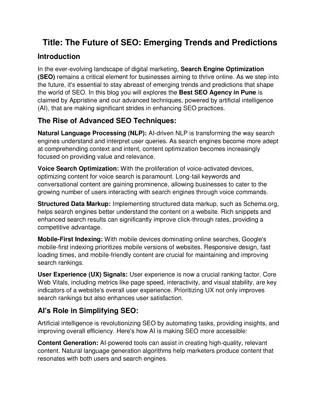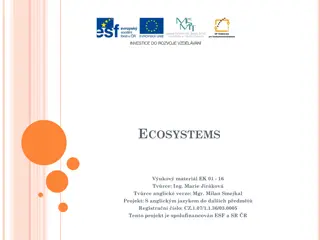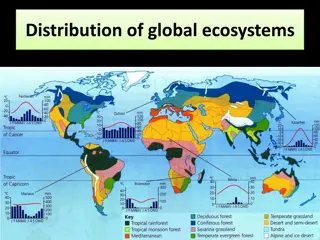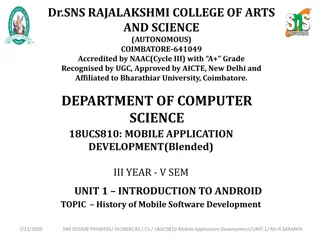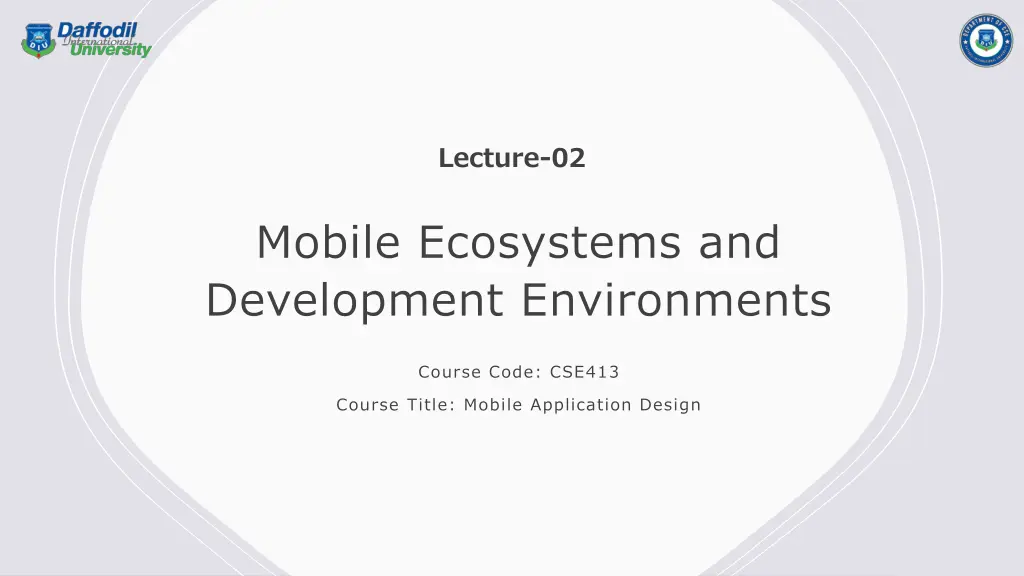
Understanding the Dynamics of Mobile Ecosystems in Application Design
Explore the intricate network of mobile ecosystems involving devices, software, services, and stakeholders to deliver a seamless user experience. Delve into key components such as manufacturers, operating systems, apps, and more that shape the mobile landscape.
Download Presentation

Please find below an Image/Link to download the presentation.
The content on the website is provided AS IS for your information and personal use only. It may not be sold, licensed, or shared on other websites without obtaining consent from the author. If you encounter any issues during the download, it is possible that the publisher has removed the file from their server.
You are allowed to download the files provided on this website for personal or commercial use, subject to the condition that they are used lawfully. All files are the property of their respective owners.
The content on the website is provided AS IS for your information and personal use only. It may not be sold, licensed, or shared on other websites without obtaining consent from the author.
E N D
Presentation Transcript
Lecture-02 Mobile Ecosystems and Development Environments Course Code: CSE413 Course Title: Mobile Application Design
Learning Outcomes Overview of mobile OS architectures Introduction to SDKs (Android SDK, iOS SDK) Role of SDK tools in supporting app design and development
What is Mobile Ecosystem? A mobile ecosystem refers to the interconnected network of devices, software, services, technologies, and stakeholders that communication, computing, and applications. It is a dynamic environment where various elements interact to provide a seamless experience for users, developers, manufacturers, and service providers. work together to enable and support mobile
Mobile Ecosystem: Key Components Mobile Manufacturers: Companies like Samsung, Apple, and Huawei that produce smartphones and tablets Operating System: Software platforms like Android and iOS that power mobile devices Mobile Apps, Mobile Websites, and Testing Tools: Applications and websites specifically designed for mobile platforms, along with tools for testing them Mobile Development Companies: Organizations that create mobile applications and websites
Mobile Ecosystem: Key Components Mobile Apps Store: Platforms like Google Play Store and Apple App Store that distribute applications to users Mobile Ad Companies: Businesses that manage advertising on mobile platforms Carrier: Network providers such as AT&T, Verizon, or T- Mobile that enable connectivity Network: Infrastructure for data transfer, including 4G, 5G, and Wi-Fi
Mobile Ecosystem: Key Components Mobile Cloud: Cloud services for storage, processing, and app integration Devices: Hardware like smartphones, tablets, and wearables Mobile Users: End-users who interact with mobile devices and apps Others: Any additional stakeholders or technologies supporting the ecosystem
Mobile OS Architectures iOS Proprietary System: Developed exclusively by Apple, ensuring uniformity. User performance. Experience: Emphasizes seamless design and high Security: Advanced encryption and app review processes for heightened safety. Hardware Integration: Designed to work specifically with Apple devices like iPhones, iPads, and Apple Watch. Development Tools: Xcode with Interface Builder and seamless App Store deployment.
Mobile OS Architectures Android Open Source: Based on Linux, allowing for greater customization. Hardware Support: Compatible with various manufacturers like Samsung, Xiaomi, and OnePlus. App Scalability: Supports a wide range of screen sizes and device configurations. Ecosystem: Integration with Google services like Gmail, Drive, and Maps. Development Tools: Android Studio with extensive debugging tools and emulators.
Introduction to SDKs Android SDK Core Components Emulator: Simulates Android devices for app testing. Debugger: Identifies and resolves code errors effectively. APIs: Provides access to hardware features like camera, sensors, and GPS. Build Tools: Assists in compiling, packaging, and deploying apps. Supported Languages: Java, Kotlin, and C++. Strengths: Compatibility with a variety of Android devices and manufacturers. Rich ecosystem of libraries and tools for rapid development. Integration with Google services (e.g., Firebase, Google Maps).
Introduction to SDKs iOS SDK Core Components: Interface Builder: Enables visual design of app interfaces. APIs: Offers access to Apple-specific features like Siri, ARKit, and Face ID. Simulators: Allows testing across various Apple devices (iPhones, iPads, etc.). Integrated Debugging Tools: Built into Xcode for efficient error detection. Supported Languages: Swift and Objective-C. Strengths Seamless integration with Apple s hardware and software ecosystem. Focus on security and performance optimization. Unified environment for consistent app development and deployment.
Role of SDK tools in supporting app design and development Design Support: Offers tools for prototyping and refining UI/UX. Ensures apps are responsive and accessible across devices. Development Support: Provides pre-built libraries and frameworks to simplify coding. Offers testing environments for debugging and app performance analysis. Deployment Support: Streamlines publishing apps to Google Play Store and Apple App Store. Helps maintain version compatibility across updates.

